Do Coyotes Attack and Eat Cats? 5 Ways to Keep Your Cat Safe
Coyotes have been villainized for as long as anyone can remember. They are blamed for so much, some of which is not true. It isn’t the coyote’s fault they must do what they need to in order to survive in a human-driven world. When wild animals are forced out of their homes because of the massive overpopulation of humans, they aren’t to blame. Urban areas, especially housing developments just erected, were once forests where it was still somewhat safe for wildlife to live. By destroying habitats for animals to live, we drive them into neighborhoods to forage for food any way they can. Coyotes are eating neighborhood cats since their food source is scarce. Let’s look at some ways to keep your cat safe by coyote proofing their area.
1. Keep Your Cat Indoors
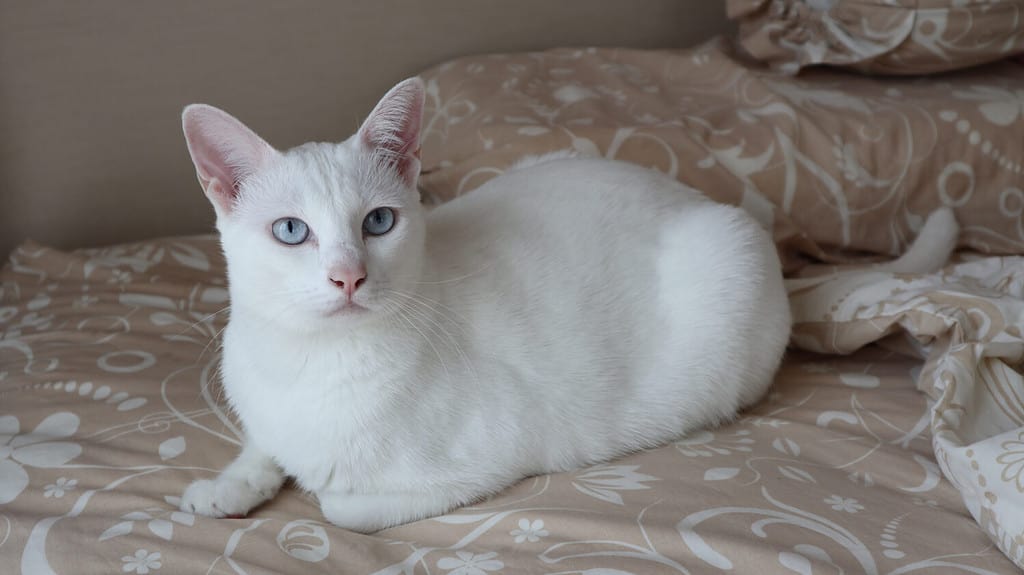
©TS Photo Album/Shutterstock.com
By keeping your cat indoors, you remove all dangers it would otherwise face outside. This is easy if you have one or two cats who have spent their lives indoors, but if you have cats that once went outside but are now being kept in, it’s another story entirely. Those cats are what is called a huge flight risk and may try to rush the door any time it is opened. The cats might get out and run because they know you’ll be close on their heels, trying to get them back to the cozy indoor life.
The cat or cats might think they’ve fooled you and sneak into the woods for what they think will be a fun night terrorizing rodents. Those cats are in danger of hungry coyotes that have become trapped in sparse woods in between housing developments and neighborhoods. The coyotes will be hungry since their food sources have dwindled down to whatever they can find on any given night.
A Sad Fate of Many Missing Cats
Many people in neighborhoods where you would least expect to see coyotes hang missing cat flyers on the telephone poles or hand out flyers in mailboxes hoping their cat is safe in your home. They will likely never find out what happened to their cat and will never find any sign of them again. Sometimes, even being an indoor cat can have some risk.
Other cats, such as feral cats, do not have a home or anywhere they typically sleep. They are nomads who go where the food is and do what they need to stay alive. They might be more fearful than Fluffy, the indoor-only cat but without any cover or escape route, they can easily be taken by a hungry coyote if they are not careful.
2. Put Your Cats in a Catio Only During the Day
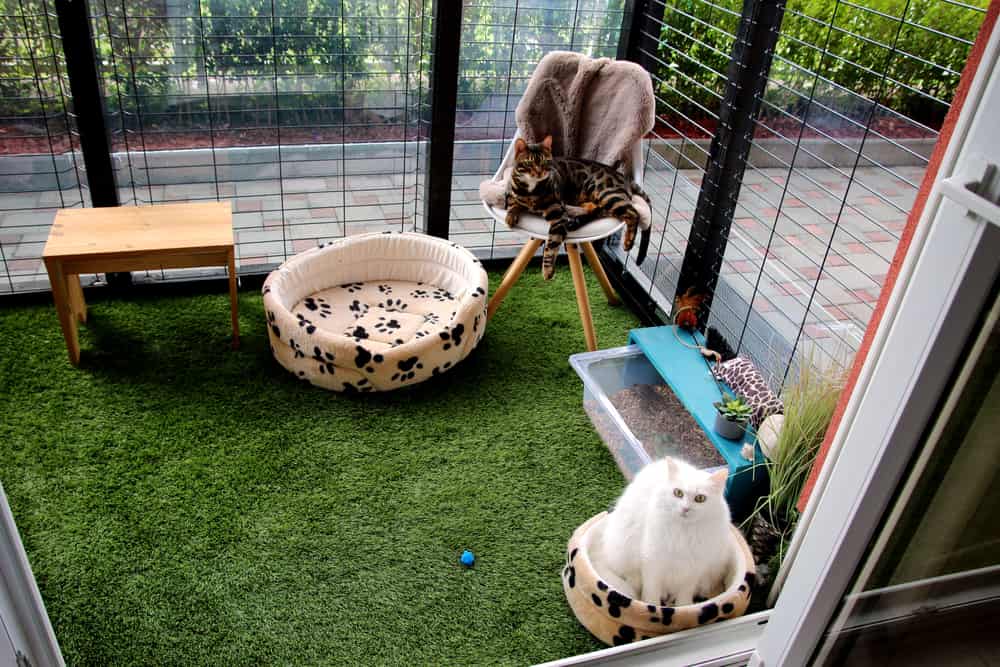
©TheCats/Shutterstock.com
Catios that are connected to your home offer very little flight risk and keep your cats happy bird watching and smelling the fresh air without the dangers of predators. Unfortunately, catios can be expensive or complicated to build but are very much worth it if you intend to live in your home long term. They are the perfect way to allow your cats some fresh air without constantly worrying if they’ll return home and, if they do, if they will show up injured.
Catios take a bit of upkeep, just like your home, to keep them looking nice, smelling good, and secure enough to keep your cats in while keeping the big bad coyotes out. Some sit directly on the grass, which is nice for the cats inside because cats love eating grass to aid in digestion.
Protect the Catio
However, if you choose to go that route, understand that a determined coyote can dig deep and far to get what they are after. It is very important to do some coyote proofing to the catio, as well. You will need to bury the catio fencing by a foot to counter the chances of them trying to dig in. It is also a great idea to bury another piece six inches underground running parallel to the surface. A determined and hungry coyote may continue to try, so be sure to bring your cats in before dark falls. Never leave food outside.
If your catio is not attached to your home and you have to carry your cat back in and out daily, put them in a secure cat carrier while in the catio and do not let them out until the door to your home is shut. Carrying them in your arms is risky because it will be easy for them to escape if they are motivated enough.
3. Remove Food Sources
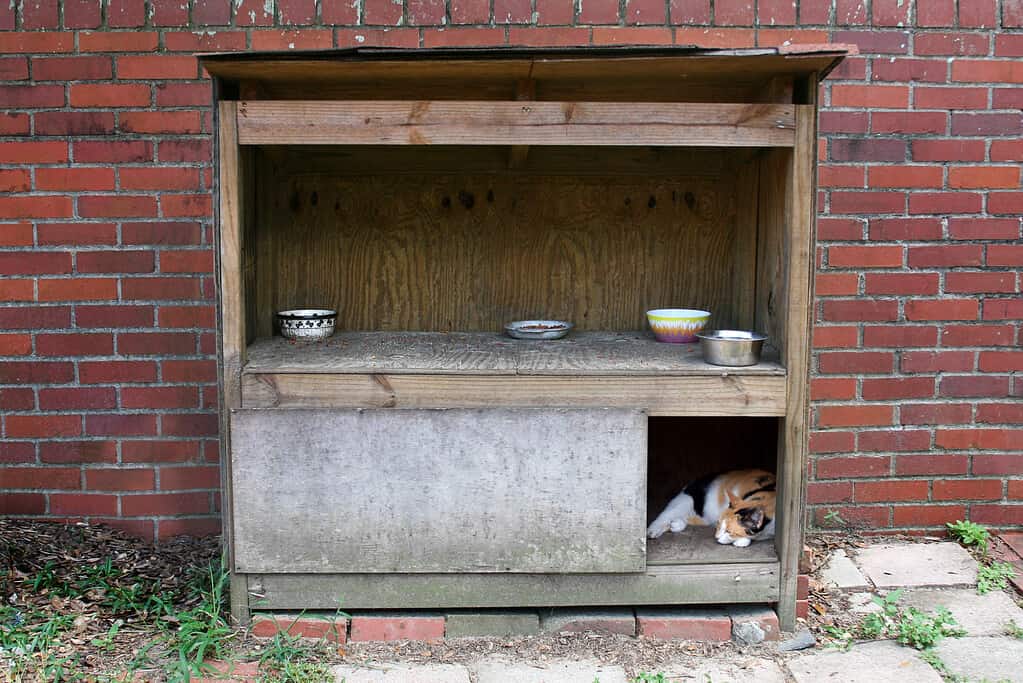
©Twinschoice/iStock via Getty Images
Feral cat stations are plentiful and offer kindness to cats otherwise homeless and hungry. They tend to draw in more cats because of the food and water sources. It isn’t always easy to pick up the food and water dishes after feeding to ensure wildlife doesn’t come along for a free snack. By leaving the food and water out, it will attract anything that’s hungry or thirsty. This is also kind, but when your focus is keeping the cat colony safe, you do not want to cause more problems for them by attracting animals that will hurt them. Catching an injured feral cat is no easy feat.
Take the Food to Great Heights
If it is not possible to take the food and water away after feeding, try placing the food high up where the cats can reach it, but a coyote could not. This isn’t ideal because the coyotes will still be drawn to the area when they smell cat food and will want to investigate. They may watch the cats to see how they get to the food and try to replicate it, or they may skip the food entirely and just eat one of the cats.
If you have a feral cat feeding station, be sure to offer many safe ways for them to escape if a coyote shows up by coyote proofing the it area. Even if the food is out of reach for a coyote, it will still be reachable to some other animals, like raccoons. Raccoons can carry rabies, and that would also be a death sentence for the cats in the colony. Use your best judgment to create the best system for your specific situation.
4. Install Coyote Proof Fencing
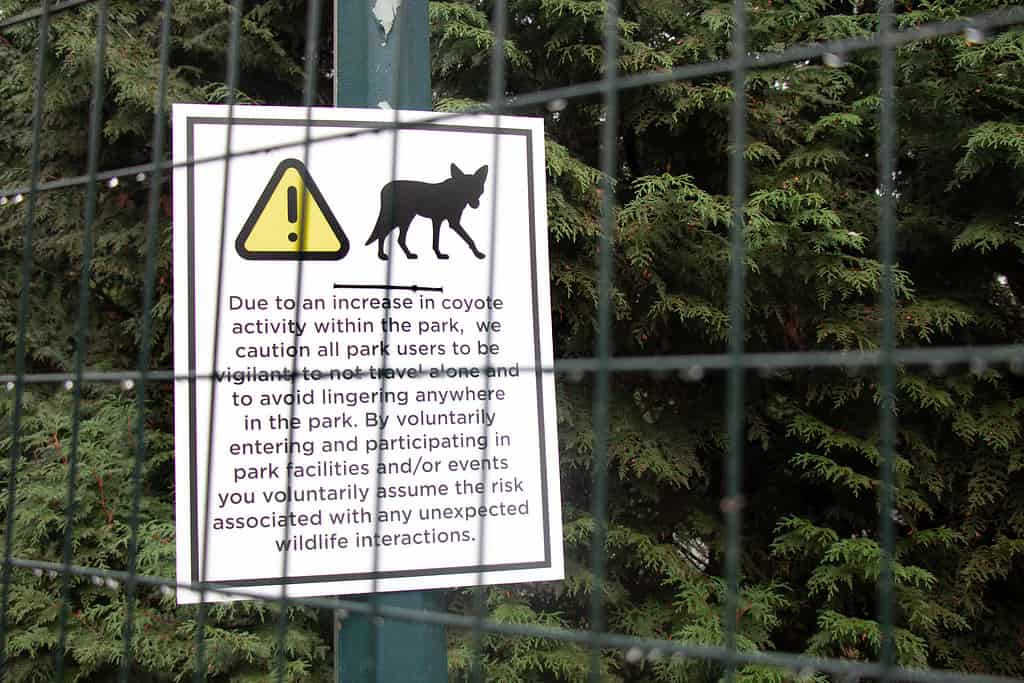
©Margarita-Young/iStock via Getty Images
Coyote-proof fencing is another excellent way to prevent an attack on your cats by a coyote. They will be able to go outside but will be confined to the fenced in area. It is imperative to use fencing like the type in the above photo, to create the right type of fencing that neither your cat nor the coyote can climb or get over. You will also want to be sure to bury the fencing a foot down and, for even more assurance, run it parallel for a foot or more if you are able to. This technique is also used for small livestock kept in coyote-dense areas.
Installing fencing alone will not guarantee maximizing the coyote proofing. Several excellent products are made to make it impossible for even the cleverest coyote to get over the toy of a fence. One is called a coyote roller top for a fence. This will also make it so your sneaky cats can’t get over your fence either. This can also be made using PVC piping.
Taking Fencing to a New Level
If you are in a rural area and are able to do so, place fencing around the area where the feral cats come to sleep and eat. Using concrete blocks with the large entrance side facing out every few blocks, line under the fence using them. Do this all the way around the fence with the fence resting on top of the blocks. This will provide a safe way for the feral cats to come and go without letting the coyote through. Of course, this won’t be possible on city property or in some other situations. Make sure to search online for the best way to create DIY coyote-proof fencing.
5. Create Cat Escape Items and Routes
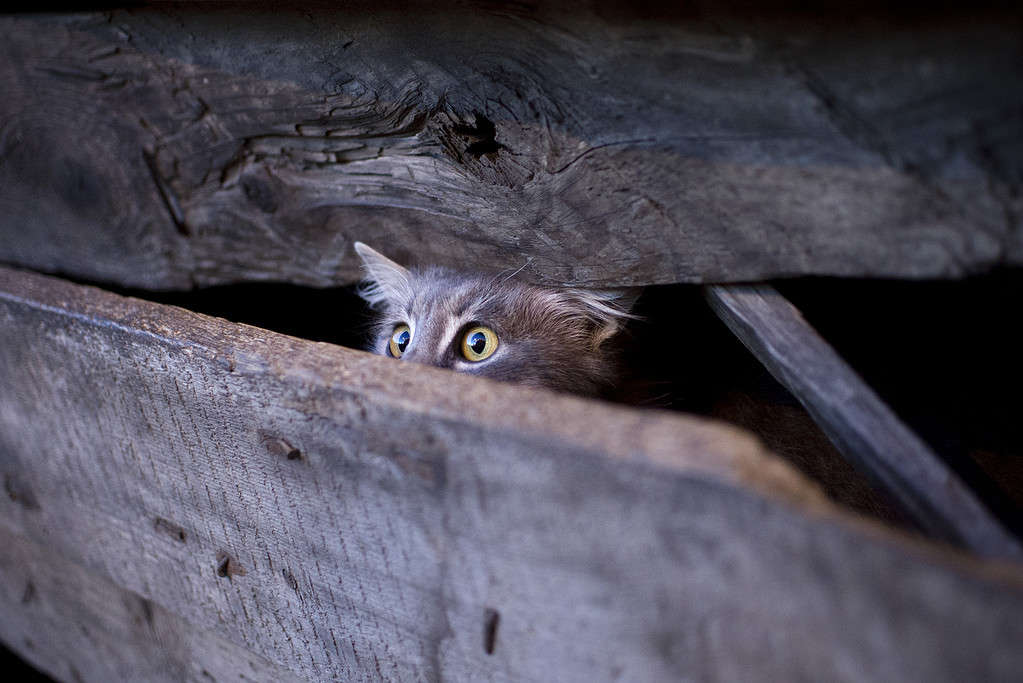
©NikolaBarbutov/iStock via Getty Images
Feral cats are by far the most frequently killed cats by coyotes. They do not have a safe place to hide like many outdoor cats and, since then, tend to run whenever there is danger, which increases the odds of a coyote chasing them. Coyotes do not chase cats for fun. They do so because they see the opportunity for an easy meal. Most coyotes would much rather catch smaller prey or eat food left out, but some will go after cats in order to survive if there are no other opportunities for food or prey.
Since feral cat colonies are easy targets, it is important to give them a bit of safety in their already difficult lives by coyote proofing the area. If nothing is available for them to climb to get away, make something. You can use 4 x 4 posts that are 12 feet tall with a foot driven beneath the ground. You can set up a floor at the top of the post where a cat would be able to climb up, go through a small hole in the floor without letting go of the post, and be safe while the coyote is still patrolling. If you are feeding many cats, try placing several of these around in different spots. Coyotes are also good at climbing but would not be able to get up a rough 4 x 4 the way a cat can.
Make Use of What’s Around the Colony
If there are buildings, junked cars, or anything that would provide a solid place to hide, try making it more accessible to the cats while being less accessible for the coyotes. Concrete blocks turned to the open side for a cat to get through when running to get under a car. Also, having the entire bottom of the vehicle enclosed with the same concrete blocks is an excellent way to make a safe zone.
If you are able to, make some concrete safety zones for the cats using concrete blocks with holes large enough for a cat to squeeze through but not a coyote. You can make several small huts with concrete blocks stacked for walls and cemented together. Use a piece of metal for the roof and attach. Running PVC tubes underground from place to place or shelter to shelter can also provide the cats with a good escape route and a way to confuse the hungry coyotes. There is tons of great info on different techniques feral cat rescues, and others have used with great success. Good luck making the best of these coyote proofing techniques, and don’t forget to search online and look at the photos for some extra inspiration.









